Sugriva
In the ancient Indian epic Ramayana, Sugriva (Sanskrit: सुग्रीव, sugrīva, lit. 'beautiful necked') was younger brother of Vali, whom he succeeded as ruler of the vanara kingdom of Kishkindha. Rumā was his wife. He was son of Surya, the Hindu deity of sun. As the king of vanara, Sugriva aided Rama in his quest to liberate his wife Sita from captivity at the hands of the Rakshasa king Ravana. This aid is referred to as Sugrivajne.
| Sugriva | |
|---|---|
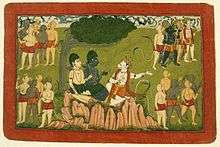 | |
| In-universe information | |
| Title | Maharaja |
| Family | Surya, Vriksharaja (when he was a female, Surya gave her/him blessings for have a successor) |
| Spouse | Rumā |
He is also known as Javanese: Sugriwa, RTGS: Su-khrip, Lao: Sugeep, Khmer: Sukhreeb, Creole: Soogrim, Lao: Sangkip, Tamil: Cukkirivan, Burmese: Thugyeik, Sugreeva or Sugreev.
The Story of Sugriva
The story of Sugriva is part of Ramayana and in an abbreviated version, is also present in the Mahabharata.
Sugriva and Vali Have A Disagreement
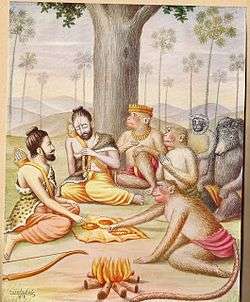
Vali ruled the kingdom of Kishkindha; his subjects were the vanaras. Tara was his wife. One day, a raging demon by the name of Maayaavi came to the gates of the capital and challenged Vali to a fight. Vali accepted the challenge, but when he sallied forth, the demon fled in terror into a deep cave. Vali entered the cave in pursuit of the demon, telling Sugriva to wait outside. When Vali did not return and upon hearing demonic shouts in the cave and seeing blood oozing from its mouth, Sugriva concluded that his brother had been killed. With a heavy heart, Sugriva rolled a boulder to seal the cave's opening, returned to Kishkindha and assumed kingship over the vanaras. Vali, however, ultimately prevailed in his combat with the demon and returned home. Seeing Sugriva acting as king, he concluded that his brother had betrayed him. Though Sugriva humbly attempted to explain himself, Vali would not listen. As a result, Sugriva was ostracized from the kingdom, Vali forcibly took Sugriva's wife Rumā and the brothers became bitter enemies.[1] Sugriva then goes on to live on Rishyamukh as it is the only place on earth that Vali cannot tread on. Vali was previously cursed by Sage Matang and hence cannot lay a foot on this piece of land. Doing so would cause his death.
Sugriva Makes An Alliance
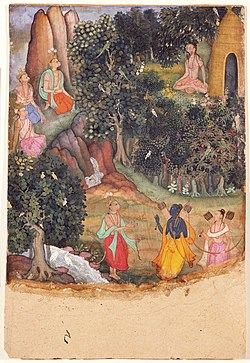
In exile, Sugriva made the acquaintance of Rama, the Avatar of Vishnu, who was on a quest to rescue his wife Sita from the demon Ravana, king of the Rakshasas. Rama promised Sugriva that he would kill Vali and would reinstate Sugriva as the king of the vanaras. Sugriva, in turn, promised to help Rama with his quest.[2]
Rama Kills Vali and hands over the kingdom to Sugriva
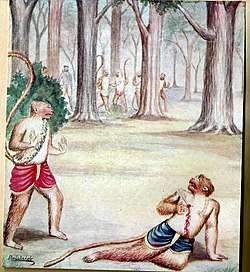
Together, Sugriva and Rama went to seek out Vali. While Rama stood back, Sugriva shouted a challenge and dared him to battle. The brothers rushed at each other, fighting with trees and stones, with fists, nails and teeth. They were evenly matched and indistinguishable to the observer, until Sugriva's counsellor Hanuman stepped forward and placed a garland of flowers around Sugriva's neck. It was then that Rama emerged with his bow and drove an arrow through Vali's heart. After Vali’s death, Sugriva reclaimed the vanara kingdom, took back his wife, Rumā and took over Vali's main wife, Tara, who became empress and her son by Vali, Angada, who became crown prince.[3]
Sugriva's Fight With Lava & Kusha
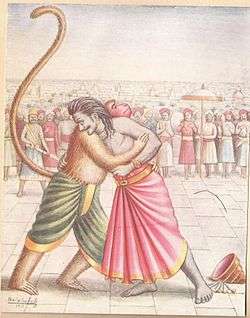
On Lakshmana's request and after Guru Vasistha's approval, Rama plans to do Ashvamedha Yagya. At this auspicious occasion he calls Sugriva along with Angada, Nala, Neela, Jambavantha and Hanuman to come to Ayodhya. Rama greets and hugs Sugriva, Jambavantha and others on their arrival to Ayodhya.
The Yagya horse was captured by Lava and Kusha brothers. In the Rama's army the news spreads that two muni kumara's has captured the Yagya's horse. Shatrughana walks and fights with Lava and he was defeated by Lava. Then Lakshamana comes and he was also defeated by Lava. Then Bharata asks Rama to give him the permission to go to set horse free from both muni Kumara. Sugriva and Hanuman also request Rama to permit them to go along with Bharata in the battle. Lava and Kusha defeat Bharata and Sugriva and take Hanuman as a prisoner. Hanuman was the only one who knew that Lava and Kush were sons of his master & Sita and thus allowed himself to be imprisoned by his master's sons.[4]
Retirement
When Rama decided to depart from the world and took samadhi in the Saryu River, Sugriva also retired from earth and went with his father Surya.
Jain Version
According to Jain texts, Sugriva was a human being and he took Jain Diksha and attained Moksha from Mangi-Tungi.[5]
Artistic and Folkloric Depictions of Sugriva
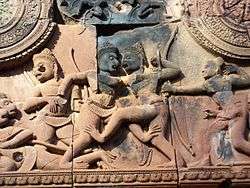
- The combat of Sugriva with his brother Vali was a favorite motif of the Khmer sculptors contributing to the Angkorian temples and monuments near Siem Reap in Cambodia.
- A detailed and moving tympanum at the 10th century Hindu temple of Banteay Srei depicts the combat of the brothers, as well as Rama's intervention and Vali's death in the arms of another vanara.
- A bas-relief at the 12th-century temple of Angkor Wat shows the fight between the brothers, arrival of Rama and Vali lying on his death-bed, mourned by many other vanaras. Another scene shows Sugriva and Rama entering into their alliance. A large bas-relief depicts the Battle of Lanka between Rama and Sugriva's army of vanaras and Ravana's army of Rakshasas.
- The fight between Vali and Sugriva is also represented at the lesser-known 13th century Angkorian temple of Preah Pithu.
Footnotes
- Ramayana of Valmiki, Book IV, Canto 9–10.
- Ramayana of Valmiki, Book IV, Canto 8, 10; Mahabharata, Book III: Varna Parva, Section 278.
- Ramayana of Valmiki, Book IV, Canto 11 ff.; Mahabharata, Book III: Varna Parva, Section 278.
- Valmiki Ramayana
- "Mangi Tungi Temple". Archived from the original on 1 October 2013.
References
- Anna Dhallapiccola, Dictionary of Hindu Lore and Legend. (ISBN 0-500-51088-1)
- Valmiki Ramayana, Ramayana written by Maharshi Valmiki.
External links
| Wikimedia Commons has media related to Sugriva. |
- The Ramayana of Valmiki, online version, English translation by Ralph T. H. Griffith.
- The Mahabharata of Vyasa, online version, English translation by Kisari Mohan Ganguli.
- Photos of the tympanum at Banteay Srei in Cambodia depicting Sugriva's combat with Vali and Rama's intervention.
.jpg)